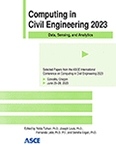Workers’ Physiological/Psychological Responses during Human-Robot Collaboration in an Immersive Virtual Reality Environment
Publication: Computing in Civil Engineering 2023
ABSTRACT
The construction industry is facing problems with low productivity rates, safety concerns, and labor shortages, leading to the adoption of robotic technologies. While robots can replace tasks requiring repeatability, power, speed, and precision, tasks requiring intelligence, flexibility, and problem-solving still need skilled human workers. For effective human-robot collaboration on highly dynamic and uncertain construction job sites, robots must be designed and controlled to earn workers’ trust. To identify trust mechanisms facilitating collaboration, this study aims to analyze human physiological/psychological responses to construction robots. Using wearable sensors, this study measured responses during virtual reality experiments in which humans worked collaboratively with robots. The results showed that robot movement speed, proximity distance, and worker engagement significantly affected human responses, but the robot’s direction of approach did not. These findings can improve collaborative task design and guidelines for improving safety and productivity in human-robot collaboration from a human-centered perspective.
Get full access to this article
View all available purchase options and get full access to this chapter.
REFERENCES
Branyon, J., and Pak, R. (2015). Investigating Older Adults’ Trust, Causal Attributions, and Perception of Capabilities in Robots as a Function of Robot Appearance, Task, and Reliability.
Brosque, C., and Fischer, M. (2022). Safety, quality, schedule, and cost impacts of ten construction robots. Construction Robotics 2022 6:2, 6(2), 163–186.
Jessup, S. A., Alarcon, G. M., Gibson, A. M., Capiola, A., and Borders, M. (n.d.). Investigating the Effect of Trust Manipulations on Affect over Time in Human-Human versus Human-Robot Interactions. Retrieved March 12, 2023, from https://hdl.handle.net/10125/63807.
Lee, J. D., and See, K. A. (2004). Trust in automation: Designing for appropriate reliance. Human Factors, 46(1), 50–80.
Liu, Y., Habibnezhad, M., and Jebelli, H. (2021). Brainwave-driven human-robot collaboration in construction. Automation in Construction, 124, 103556.
Macarthur, K. R., Stowers, K., and Hancock, P. A. (2017). Human-robot interaction: Proximity and speed—slowly back away from the robot! Advances in Intelligent Systems and Computing, 499, 365–374.
Mayer, R. C., Davis, J. H., and Schoorman, F. D. (1995). An Integrative Model Of Organizational Trust. Academy of Management Review, 20(3), 709–734.
Michalos, G., Makris, S., Tsarouchi, P., Guasch, T., Kontovrakis, D., and Chryssolouris, G. (2015). Design Considerations for Safe Human-robot Collaborative Workplaces. Procedia CIRP, 37, 248–253.
Padhmashree, V., and Bhattacharyya, A. (2022). Human emotion recognition based on time–frequency analysis of multivariate EEG signal. Knowledge-Based Systems, 238, 107867.
Plutchik, R. (1980). A general psychoevolutionary theory of emotion. Theories of Emotion, 3–33.
Rahman, M. M., Sarkar, A. K., Hossain, M. A., Hossain, M. S., Islam, M. R., Hossain, M. B., Quinn, J. M. W., and Moni, M. A. (2021). Recognition of human emotions using EEG signals: A review. Computers in Biology and Medicine, 136, 104696.
Schniter, E., Shields, T. W., and Sznycer, D. (2020). Trust in humans and robots: Economically similar but emotionally different. Journal of Economic Psychology, 78, 102253.
Siegel, M., Breazeal, C., and Norton, M. I. (2009). Persuasive robotics: The influence of robot gender on human behavior. 2009 IEEE/RSJ International Conference on Intelligent Robots and Systems, IROS 2009, 2563–2568.
Smith, A., and Anderson, M. (2017). Automation in Everyday Life. Pew Research Center.
Stephan, W. G., Stephan, C. W., and Gudykunst, W. B. (1999). Anxiety in intergroup relations: a comparison of anxiety/uncertainty management theory and integrated threat theory. International Journal of Intercultural Relations, 23(4), 613–628.
Wu, M., Lin, J. R., and Zhang, X. H. (2022). How human-robot collaboration impacts construction productivity: An agent-based multi-fidelity modeling approach. Advanced Engineering Informatics, 52, 101589.
You, S., Paris, H., and Robert, L. P. (n.d.). Trusting Robots in Teams: Examining the Impacts of Trusting Robots on Team Performance and Satisfaction. Retrieved March 14, 2023, from https://ssrn.com/abstract=3308180.
You, S., Kim, J. H., Lee, S. H., Kamat, V., and Robert, L. P. (2018). Enhancing perceived safety in human–robot collaborative construction using immersive virtual environments. Automation in Construction, 96, 161–170.
Information & Authors
Information
Published In
History
Published online: Jan 25, 2024
ASCE Technical Topics:
- Automation and robotics
- Business management
- Construction engineering
- Construction industry
- Construction management
- Construction sites
- Employment
- Engineering fundamentals
- Human and behavioral factors
- Labor
- Models (by type)
- Occupational safety
- Personnel management
- Practice and Profession
- Public administration
- Public health and safety
- Safety
- Simulation models
- Systems engineering
Authors
Metrics & Citations
Metrics
Citations
Download citation
If you have the appropriate software installed, you can download article citation data to the citation manager of your choice. Simply select your manager software from the list below and click Download.
